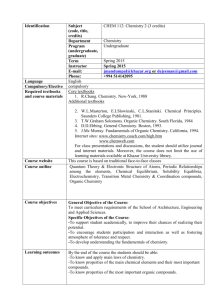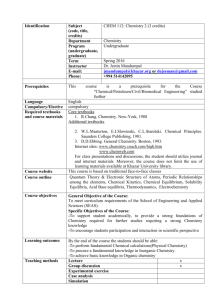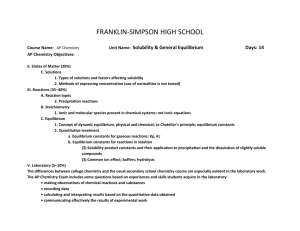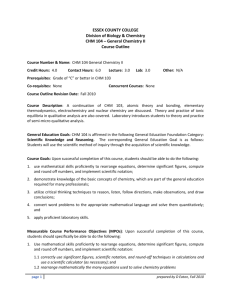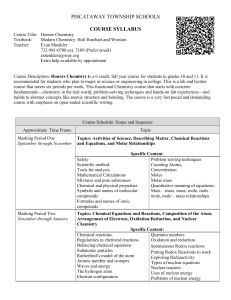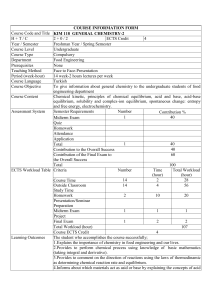Identification - Khazar University
advertisement
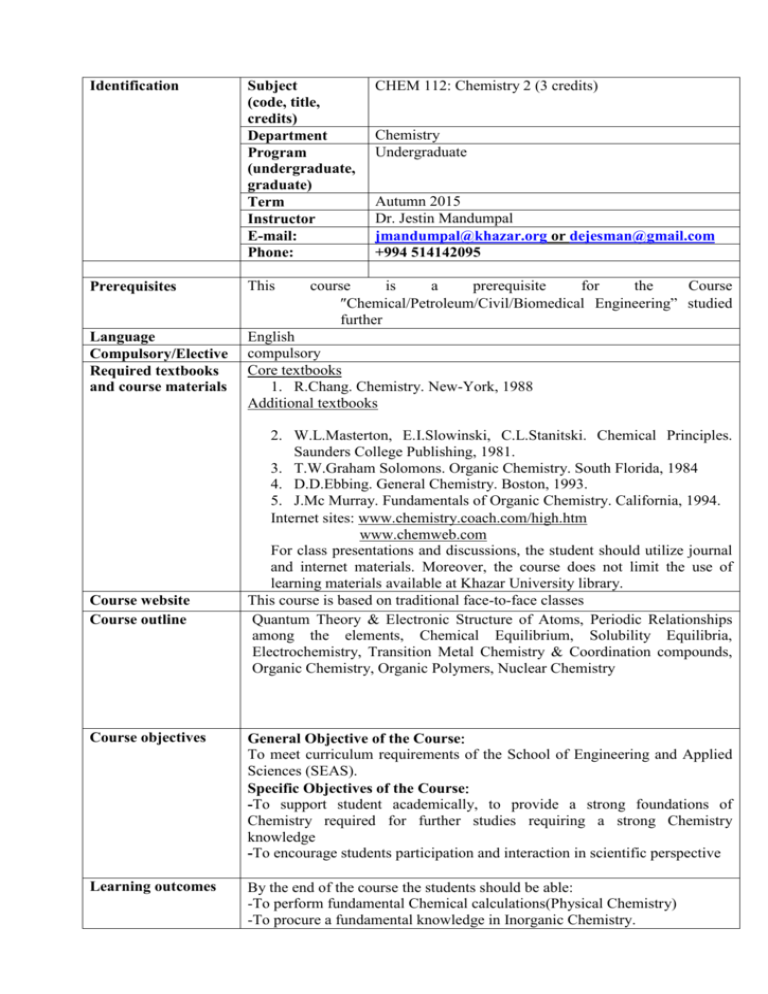
Identification Subject (code, title, credits) Department Program (undergraduate, graduate) Term Instructor E-mail: Phone: CHEM 112: Chemistry 2 (3 credits) Chemistry Undergraduate Autumn 2015 Dr. Jestin Mandumpal jmandumpal@khazar.org or dejesman@gmail.com +994 514142095 Prerequisites This Language Compulsory/Elective Required textbooks and course materials English compulsory Core textbooks 1. R.Chang. Chemistry. New-York, 1988 Additional textbooks Course website Course outline course is a prerequisite for the Course Chemical/Petroleum/Civil/Biomedical Engineering” studied further 2. W.L.Masterton, E.I.Slowinski, C.L.Stanitski. Chemical Principles. Saunders College Publishing, 1981. 3. T.W.Graham Solomons. Organic Chemistry. South Florida, 1984 4. D.D.Ebbing. General Chemistry. Boston, 1993. 5. J.Mc Murray. Fundamentals of Organic Chemistry. California, 1994. Internet sites www.chemistry.coach.com/high.htm www.chemweb.com For class presentations and discussions, the student should utilize journal and internet materials. Moreover, the course does not limit the use of learning materials available at Khazar University library. This course is based on traditional face-to-face classes Quantum Theory & Electronic Structure of Atoms, Periodic Relationships among the elements, Chemical Equilibrium, Solubility Equilibria, Electrochemistry, Transition Metal Chemistry & Coordination compounds, Organic Chemistry, Organic Polymers, Nuclear Chemistry Course objectives General Objective of the Course To meet curriculum requirements of the School of Engineering and Applied Sciences (SEAS). Specific Objectives of the Course -To support student academically, to provide a strong foundations of Chemistry required for further studies requiring a strong Chemistry knowledge -To encourage students participation and interaction in scientific perspective Learning outcomes By the end of the course the students should be able -To perform fundamental Chemical calculations(Physical Chemistry) -To procure a fundamental knowledge in Inorganic Chemistry. Teaching methods Evaluation Policy -To achieve basic knowledge in Organic chemistry x Lecture x Group discussion Experimental exercise Case analysis Simulation x Course paper Others Methods Date/deadlines Percentage (%) November, 2015 30 Midterm Exam 20 Assignment and quizzes 10 Presentation/Group Discussion February, 2015 40 Final Exam 100 Total Attendance The students are required to attend all classes as a part of their studies and those having legitimate reasons for absence (illness, family bereavement, etc.) are required to inform the instructor. Tardiness / other disruptions. If a student is late to the class for more than 10 (ten) minutes, (s)he is not allowed to enter and disturb the class. However, this student is able to enter the second double hours without delaying. Exams In order to be excused from the exam, the student must contact the dean and the instructor before the exam. Excuse will not be granted for social activities such as trips, cruises and sporting events (unless you are participating). The exams will all be cumulative. Most of the questions on each exam will be taken from the chapters covered since the last exam. But some will come from the earlier chapters. In general the coverage will reflect the amount of the time spend in class on the different chapters. Withdrawal (pass / fail) This course strictly follows grading policy of the School of Engineering and Applied Sciences. Thus, a student is normally expected to achieve a mark of at least 60% to pass. In this case of failure, he/she will be referred or required to repeat the course the following term or year. Cheating / plagiarism Cheating or other plagiarism during midterm and final examinations will lead to paper cancellation. In case, the student will automatically get 0 (zero), without any considerations. Professional behavior guidelines The student shall behave in the way to create favorable academic and professional environment during the class hours. Unauthorized discussions and unethical behavior are strictly prohibited. Use of any electronic devices is prohibited in the classroom. All devices should be turned off before entering class. This is a university policy and violators will be reprimanded accordingly For successful completion of the course, the students shall take an active part during the class time, raising questions and involving others to discussions. Learning and Teaching Methods This course considers active learning process rather than passive one. Week 1 Sept 15-21 2015 Tentative Schedule Topics Topic 1 i. ii. iii. 2 Sept 22-28 2015 1 iv. v. vi. vii. viii. 3 Sept 29 - Oct 5 2015 4 Oct 6-13 2015 1 2 Quantum theory and the electronic structure of atoms From Classical Physics to Quantum Theory(217) Properties of waves (219), Electromagnetic radiation (221), Planck’s quantum theory (223) The photoelectric effect(224) Bohr’s theory of the Hydrogen atom(225) Emission spectra(225), Emission spectrum of the hydrogen atom (227) The dual nature of the electron (233) Quantum Mechanics (236) Applying Schrödinger equation to the Hydrogen atom (238) Quantum numbers (239) The principal quantum number (239), The angular momentum quantum number (239), The magnetic quantum number (240), The electron spin quantum number (240) Atomic orbitals (241) Electron configuration (246) The Pauli Exclusion Principle (247), Diamagnetism and Para magnetism (248), The shielding effect in many electron atoms (248), Hund’s rule (249), General rules for assigning electrons to atomic orbitals (251) x. Building up Principle of the periodic table (253) xi. Review of the topic Periodic Relationships among the elements i. Development of periodic table (264) ii. periodic classification of the elements (267) Representing free elements in chemical equations (270), Electron configurations of cations and anions (271), Ions derived from representative elements (271), Cations derived from Transition metals (272) iii. periodic variation in physical properties (273) Effective nuclear charge (273), atomic radius (274), ionic radius (276), Variation in physical properties across a period (278), predicting physical Textbook/Assignments [1] [1] ix. [1] [1] iv. v. vi. 5 2 vii. viii. properties (280) ionization energies (281) Ionisation energies in many electron atoms (282) Electron affinity (285) General trends in Chemical Properties (287), Chemical Properties in individual groups (288), Comparison of group 1A and 1B elements (295), Properties of oxides across a period (296) Variation in Chemical Properties Review of the topic Oct 14 -20 2015 3 6 i. ii. Oct 21-27 2015 iii. iv. v. vi. Chemical Equilibrium the concept of Equilibrium (576) Chemical Equilibrium (578) The magnitude of equilibrium constant (578) Ways of Expressing equilibrium constants (579) Homogenous equilibria (579), Heterogeneous equilibria (584), multiple equilibria (587), the form of K and the equilibrium equation (588), Summary of rules for writing equilibrium constant expressions(590) Relationship between Chemical Kinetics and Chemical Equilibrium (590) What does the equilibrium constant tell us? (591) Predicting the direction of a reaction (592), Calculating equilibrium concentrations (593) Factors that affect chemical equilibrium (597) Le Chatelier’s principle (597), Changes in concentrations (597), Changes in volume and pressure (600), Changes in Temperature (602), The effect of a catalyst(602), summary of factors that may affect the equilibrium position (603) [1] [1] 7 Oct 28 Nov 3 2015 4 i. ii. iii. iv. v. vi. 8 Nov 4-10 2015 1-4 9 Nov 11-17 2015 5 Review topics:: Quantum theory and electronic structure of atoms, Periodic Relationships among the elements, Chemical Equilibrium, Solubility Equilibria Midterm exam :: topic 1-4 [1] [1] Transition metal Chemistry and Coordination Compounds i. Properties of Transition metals(910) General Physical Properties(911), Electron configuration(911), Oxidation states(912), Color (914), Magnetism (914), Complex ion formation (915), Catalytic properties (915) ii. Chemistry of First row of transition [1] i. ii. iii. iv. v. 5 [1] Electrochemistry Redox reactions, a review (760) Galvanic cells (761) Standard electrode potentials (762) Spontaneity of redox reactions (768) Effect of concentration on cell EMF(773) Nernst equation(773), Concentration cells(777) Batteries (778) Dry cell battery (778), Mercury battery (778), Lead storage battery(779), Nickel-Cadmium battery(780), Fuel cells (780), Aluminium-air batter (782) Corrosion(784) Electrolysis(787) Electrolysis of molten NaCl(788), Electrolysis of Water(788), Electrolysis of aqueous NaCl solution (790), Qualitative aspects of electrolysis (791) Review Electrochemistry(760-787) vi. 10 Nov 18-24 2015 Solubility Equilibria Solubility and solubility product (696) Solubility product (696), Solubility equilibria for sulfides (698), Molar solubility and solubility (699), Predicting precipitation reactions(703) Separation of ions by fraction precipitation (704) The common ion effect and solubility(705) pH and solubility (708) Complex ion equilibria and solubility (712) Application of solubility product principle to qualitative analysis (716) vii. viii. ix. [1] . 11 Nov 25-31 2015 6 iii. iv. v. 12 Dec 1-7 2015 6 13 Dec 8-14 2015 7 14 Dec 15-21 2015 8 15 Dec 22-28 2015 9 vi. vii. metals(915) Scandium(915), Titanium (915), Vanadium (917), Chromium(917), Manganese (918), Iron (919), Cobalt (920), Nickel (921), Copper (920) Coordination compounds(921) Oxidation number pf metals in coordination compounds (924), Naming of coordination compounds (924) Stereochemistry of coordination compounds (926) Geometric isomers (927), Optical isomers(928) Bonding in coordination compounds(931) Crystal field theory (931) Reactions of coordination compounds Applications of coordination compounds(938) Metallurgy(939), Therapeutic chelating agents (939), Chemical analysis (939), Plant growth (940), Detergents (940) viii. Review Transition metal Chemistry and Coordination Compounds(910-938) Organic Chemistry i. Hydrocarbons (950) Alkanes, alkenes, alkynes, aromatic hydrocarbons ii. Functional groups (965) Alcohols, Ethers, Aldehydes and Ketones, Carboxylic acids, Esters, Amines, iii. Chemistry in action : Petroleum industry (972) iv. Review of the topic (950-972) Organic Polymers: Synthetic and Natural i. Properties of polymers (982) ii. Synthetic Organic Polymers (983) Addition reactions (983), Condensation reactions(988) iii. Proteins (991) iv. Nucleic acids (1002) v. Review of the topic (982-1002) Nuclear Chemistry i. The nature of nuclear reactions(1010) ii. Nuclear stability(1012) Nuclear binding energy(1015) iii. Natural radioactivity(1018) Kinetics of radioactive decay(1022), Dating based radioactive decay(1020) iv. Artificial radioactivity(1022) [1] [1] [1] Jan 2016 Nuclear transmutation(1022), The trans uranium elements(1024) v. Nuclear fission(1025) The atomic bomb (1026), Nuclear Reactors (1027) vi. Nuclear fusion(1034) Fusion reactors (1035), The hydrogen bomb(1037) vii. Applications of isotopes(1038) Structural determination (1038), Study of photosynthesis (1038), Isotopes in medicine (1039) viii. Biological effects of radiation(1040) ix. Review of the topic (1010-1040) Tutorials Problem solving sessions Final exam :: Feb 2016:: topics 5-9 This syllabus is a guide for the course and any modifications to it will be announced in advance.
